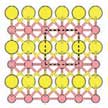
The industrial production of ammonia mostly relies on the energy-intensive Haber-Bosch process, which causes significant environmental pollution. Researchers have now proposed that a class of 2D transition metal borides termed MBenes - the boron-analogues of MXenes - could be used as catalyst for ammonia production through electrochemical nitrogen reduction reaction (NRR). This work also provides a general design principle for further exploration of an even broader composition space of MBenes and other 2D NRR electrocatalysts.
